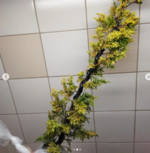bdmatt
Mame
I recently purchased 6 kishu junipers of similar size and health from a couple different sources. Of those 6, there was a kishu with much more compact, tighter, and darker foliage than the rest. It looked similar to a sekka hinoki and was different enough from the other kishus to make me wonder if it was a different variety or subvariety.
Does anyone know if there's a textbook or website describing specific subcultivars of shimpakus?
Does anyone know if there's a textbook or website describing specific subcultivars of shimpakus?



